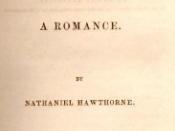Throughout The Scarlett Letter, Hester Pryne, the main character, suffered through various amounts of embarrassment and ridicule. Although anyone else might succumb to the terrible pressure that is bestowed upon you, Hester Pryne was able to overcome it and rise from the ashes left from her life of humiliation and ridicule. She resembles a magnificent phoenix overcoming its period of death and starting anew.
Hester, after leaving the jailhouse, first shows the people of Boston that they cannot suppress her creative soul and free nature. Her punishment, wearing the scarlet letter ÃÂA,ÃÂ is ÃÂfantastically embroidered and illuminated upon her bosom.ÃÂ Being a brilliant seamstress allowed her to show that, although different from the crowd, she was beautiful in her own respect. Wearing the letter upon her bosom in such a brilliant fashion also showed that Hester was well aware that she sinned in the eyes of the Puritans and God.
She understood that she was capable of transgression because she was human, something her fellow Puritans did not acknowledge.
After suffering public embarrassment on the scaffold and spending time in jail, Hester moved into a cottage on the outskirts of the town, near the forest. In order to make a living, she took up a job as a seamstress and created clothing for many citizens of Boston. Throughout this time, the Puritans still shun her for her sinful nature. Children also shun her daughter Pearl at this point. Hester shows her strength and determination for the duration of this period by staying in Boston even though she had the choice to leave. Several reasons dawn upon Hester as to why she cannot just simply abandon Boston. She believes that Boston, being the place of her ÃÂcrimeÃÂ should also be the place of her retribution. Nathaniel Hawthorne himself also states that Hester has been too deeply marked by her actions to leave Boston. Hester, through troubling circumstances, show thatÃÂdirectly and indirectlyÃÂshe is strong enough to endure her punishment.
Closely arriving at the climax of the book, Hester is taking a walk in the woods with her daughter. She has not made it clear to Pearl that she is yearning to meet Dimmesdale. Pearl, seven at this point, has become quite the observant child. She asks her mother why the ÃÂsunshine doesnÃÂt love her. Its runs away and hides itselfÃÂ ÃÂ Sunshine is the vital force to plants. Vegetation withers and dies without the powerful light of the sun. The scarlet letter upon HesterÃÂs bosom generally operated as a barrier, blocking the sun. Much like plants without sunlight, Hester withers away and slowly becomes an old shell of her once stunning self. While meeting with Dimmesdale, though, Hester sheds her scarlet letter in delight. At that moment, when released of her stigma, Hester felt absolute relief and freedom. She rejoiced, for her burden of shame and anguish was gone. The whole richness of her beauty and passion had returned. At once, sunshine burst forth through the trees, illuminating the dark forest, scattering its pure gentle light upon Hester, further accenting her freedom from burden and shame.
Through HesterÃÂs actions, she has set such an immeasurable example for us. During her life, she was shunned from society because of a sin she committed. At the whim of those around her, Hester suffered through ridicule and embarrassment. Hester overcame her troubles and was not hindered by Puritan beliefs. She continued to express her nature in what she did, shedding herself of guilt and shame in the process and gaining that freedom she rightfully deserved.
(Quotes from "The Scarlet Letter" by Nathaniel Hawthorne)





